STS-31: launching Hubble
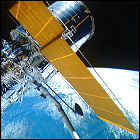 In the planning stages since the 1970s, and delayed by the post-Challenger-disaster downtime for the shuttle program, the Hubble Space Telescope is finally lifted into orbit aboard Space Shuttle Discovery. Hubble is just one of the scientific payloads for the five-day flight, with other experiments being conducted in the crew cabin and the cargo bay. Discovery’s crew for this flight is Commander Loren Shriver, Pilot Charles Bolden, and mission specialists Steven Hawley, Bruce McCandless and Kathryn Sullivan.
In the planning stages since the 1970s, and delayed by the post-Challenger-disaster downtime for the shuttle program, the Hubble Space Telescope is finally lifted into orbit aboard Space Shuttle Discovery. Hubble is just one of the scientific payloads for the five-day flight, with other experiments being conducted in the crew cabin and the cargo bay. Discovery’s crew for this flight is Commander Loren Shriver, Pilot Charles Bolden, and mission specialists Steven Hawley, Bruce McCandless and Kathryn Sullivan.
STS-33
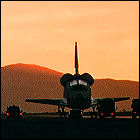 Space Shuttle Discovery lifts off on 1989’s fifth and final shuttle launch, delivering a classified Defense Department payload into orbit on a five-day mission. Aboard Discovery are Commander Frederick Gregory, Pilot John Blaha, and mission specialists Story Musgrave, Manley Carter, and Kathryn Thornton.
Space Shuttle Discovery lifts off on 1989’s fifth and final shuttle launch, delivering a classified Defense Department payload into orbit on a five-day mission. Aboard Discovery are Commander Frederick Gregory, Pilot John Blaha, and mission specialists Story Musgrave, Manley Carter, and Kathryn Thornton.
STS-29
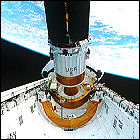 Space Shuttle Discovery lifts off on a nearly-five-day mission to take NASA’s third TDRS (Tracking & Data Relay Satellite) into orbit, among other smaller experiment packages, including IMAX filming. Aboard Discovery for the first shuttle flight of 1989 are Commander Michael Coats, Pilot John Blaha, and mission specialists James Bagian, James Buchli, and Robert Springer.
Space Shuttle Discovery lifts off on a nearly-five-day mission to take NASA’s third TDRS (Tracking & Data Relay Satellite) into orbit, among other smaller experiment packages, including IMAX filming. Aboard Discovery for the first shuttle flight of 1989 are Commander Michael Coats, Pilot John Blaha, and mission specialists James Bagian, James Buchli, and Robert Springer.
STS-26
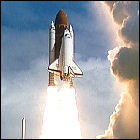 The first Space Shuttle launch in over two years since the Challenger accident, Discovery lifts off on a flight to test improved safety systems and procedures. The shuttle’s major payload is the second TDRS (Tracking & Data Relay Satellite) launched by NASA (an identical satellite was lost in the Challenger explosion in 1986), as well as numerous smaller experiments. Problems with Discovery’s environmental system cause the crew cabin to be warmer than usual. Discovery’s crew for this flight consists of Commander Fred Hauck, Pilot Richard Covey, and mission specialists John Lounge, George Nelson, and David Hilmers.
The first Space Shuttle launch in over two years since the Challenger accident, Discovery lifts off on a flight to test improved safety systems and procedures. The shuttle’s major payload is the second TDRS (Tracking & Data Relay Satellite) launched by NASA (an identical satellite was lost in the Challenger explosion in 1986), as well as numerous smaller experiments. Problems with Discovery’s environmental system cause the crew cabin to be warmer than usual. Discovery’s crew for this flight consists of Commander Fred Hauck, Pilot Richard Covey, and mission specialists John Lounge, George Nelson, and David Hilmers.
STS-51I
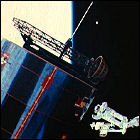 Space Shuttle Discovery lifts off on a mission to deliver three communications satellites to orbit. The triple payload includes SYNCOM IV-4, the Australian AUSSAT-1 satellite, and American Satellite Company’s ASC-1. Discovery is manned on this mission by Commander Joe Engle, Pilot Richard Covey, and mission specialists James van Hoften, John Lounge and William Fisher. The mission lasts one week, and Discovery is able to return home a day early after achieving mission objectives ahead of time.
Space Shuttle Discovery lifts off on a mission to deliver three communications satellites to orbit. The triple payload includes SYNCOM IV-4, the Australian AUSSAT-1 satellite, and American Satellite Company’s ASC-1. Discovery is manned on this mission by Commander Joe Engle, Pilot Richard Covey, and mission specialists James van Hoften, John Lounge and William Fisher. The mission lasts one week, and Discovery is able to return home a day early after achieving mission objectives ahead of time.
STS-51G
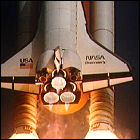 Space Shuttle Discovery returns to orbit for a week-long flight including the deployment of three communications satellites. American, Mexican and Saudi Arabian satellites are launched via payload assist modules. Discovery crew consists of Commander Daniel Brandenstein, Pilot John Creighton, mission specialists Shannon Lucid, John Fabian and Steven Nagel, and payload specialists Patrick Baudry and Sultan Salman Al-Saud (the first Saudi Arabian national to fly in space).
Space Shuttle Discovery returns to orbit for a week-long flight including the deployment of three communications satellites. American, Mexican and Saudi Arabian satellites are launched via payload assist modules. Discovery crew consists of Commander Daniel Brandenstein, Pilot John Creighton, mission specialists Shannon Lucid, John Fabian and Steven Nagel, and payload specialists Patrick Baudry and Sultan Salman Al-Saud (the first Saudi Arabian national to fly in space).
STS-51D
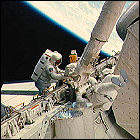 After a month of delays due to damage and a change in the flight schedule, Space Shuttle Discovery returns to orbit for a week-long flight. A Canadian communications satellite and the LEASAT-3 satellite are redeployed, but LEASAT continues to malfunction despite multiple attempts to active and launch it. Discovery’s crew on this flight consists of Commander Karol Bobko, Pilot Donald Williams, mission specialists Rhea Seddon, Jeffrey Hoffman and David Griggs, and payload specialists Charles Walker and Senator Jake Garn, the first member of the U.S. Congress to fly in space while in office. This flight’s return to the runway at Kennedy Space Center marks the first time a shuttle orbiter experiences significant damage upon landing, including a blowout of one of its landing gear wheels.
After a month of delays due to damage and a change in the flight schedule, Space Shuttle Discovery returns to orbit for a week-long flight. A Canadian communications satellite and the LEASAT-3 satellite are redeployed, but LEASAT continues to malfunction despite multiple attempts to active and launch it. Discovery’s crew on this flight consists of Commander Karol Bobko, Pilot Donald Williams, mission specialists Rhea Seddon, Jeffrey Hoffman and David Griggs, and payload specialists Charles Walker and Senator Jake Garn, the first member of the U.S. Congress to fly in space while in office. This flight’s return to the runway at Kennedy Space Center marks the first time a shuttle orbiter experiences significant damage upon landing, including a blowout of one of its landing gear wheels.
STS-51C
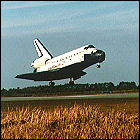 Space Shuttle Discovery lifts off on the shortest shuttle flight since the 1981 test flights, lasting only three days. A classified Defense Department payload is delivered to orbit, with the help of the first Inertial Upper Stage booster developed by the U.S. Air Force. This mission is the first time that shuttles had to be swapped out prior to flight – thermal tile issues on Challenger prevented that shuttle from being used for this mission – as well as the first instance of a shuttle launch scrubbed because of concerns over freezing weather and ice at the launch site. Discovery returns via the Kennedy Space Center runway, with Commander Ken Mattingly, Pilot Loren Shriver, mission specialists Ellison Onizuka and James Buchli, and payload specialist Gary Payton aboard.
Space Shuttle Discovery lifts off on the shortest shuttle flight since the 1981 test flights, lasting only three days. A classified Defense Department payload is delivered to orbit, with the help of the first Inertial Upper Stage booster developed by the U.S. Air Force. This mission is the first time that shuttles had to be swapped out prior to flight – thermal tile issues on Challenger prevented that shuttle from being used for this mission – as well as the first instance of a shuttle launch scrubbed because of concerns over freezing weather and ice at the launch site. Discovery returns via the Kennedy Space Center runway, with Commander Ken Mattingly, Pilot Loren Shriver, mission specialists Ellison Onizuka and James Buchli, and payload specialist Gary Payton aboard.
STS-51A
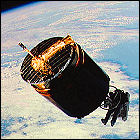 Space Shuttle Discovery takes off on a week-long satellite deployment mission, delivering a Canadian communications satellite and another American SYNCOM defense communications satellite into orbit. Using the MMU jet packs, Discovery’s crew retrieve two satellites placed into the wrong orbits by malfunctioning boosters after a shuttle mission earlier in the year, returning them to the cargo bay for return to Earth. Discovery’s crew consists of Commander Frederick Hauck, Pilot David Walker, and mission specialists Anna Fisher, Dale Gardner, and Joseph Allen.
Space Shuttle Discovery takes off on a week-long satellite deployment mission, delivering a Canadian communications satellite and another American SYNCOM defense communications satellite into orbit. Using the MMU jet packs, Discovery’s crew retrieve two satellites placed into the wrong orbits by malfunctioning boosters after a shuttle mission earlier in the year, returning them to the cargo bay for return to Earth. Discovery’s crew consists of Commander Frederick Hauck, Pilot David Walker, and mission specialists Anna Fisher, Dale Gardner, and Joseph Allen.
STS-41D: Discovery’s debut
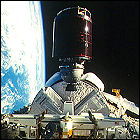 Space Shuttle Discovery makes its first flight into space on a mission to deploy three commercial communications satellites. Tested on this flight is a huge solar power panel which unfolds vertically from Discovery’s cargo bay, testing technology for space station designs still on the drawing board. Discovery’s crew for this flight consists of Commander Henry Hartsfield, Pilot Michael Coats, mission specialists Judy Resnick, Steven Hawley, Mike Mullane, and payload specialist Charles Walker.
Space Shuttle Discovery makes its first flight into space on a mission to deploy three commercial communications satellites. Tested on this flight is a huge solar power panel which unfolds vertically from Discovery’s cargo bay, testing technology for space station designs still on the drawing board. Discovery’s crew for this flight consists of Commander Henry Hartsfield, Pilot Michael Coats, mission specialists Judy Resnick, Steven Hawley, Mike Mullane, and payload specialist Charles Walker.
Discovery under construction
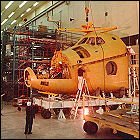 With NASA anticipating ramping up its launch schedule to more than one shuttle flight per month to meet demand for the vehicle’s unique satellite deployment and retrieval capabilities, construction begins on the third orbiter intended for spaceflight, Space Shuttle Discovery. Construction and checking of the third shuttle takes almost exactly four years, with Discovery’s first liftoff about a year later.
With NASA anticipating ramping up its launch schedule to more than one shuttle flight per month to meet demand for the vehicle’s unique satellite deployment and retrieval capabilities, construction begins on the third orbiter intended for spaceflight, Space Shuttle Discovery. Construction and checking of the third shuttle takes almost exactly four years, with Discovery’s first liftoff about a year later.
Christening the fleet
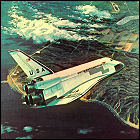 After several years of referring to the various Space Shuttle orbiters both under construction and in planning by numbers, NASA bestows names upon the anticipated fleet of four orbiters. OV-102, which is still expected to fly “late this year”, is named Columbia, while OV-099, undergoing conversion from a test article to flight-worthy vehicle, is named Challenger. Orbiters 103 and 104 will be named, respectively, Discovery and Atlantis; all four names are drawn from historical seafaring exploration vessels. (NASA has also used some of the names before: Columbia was the name of the moon-orbiting command module in the Apollo 11 mission, while Apollo 17’s lunar lander was named Challenger.)
After several years of referring to the various Space Shuttle orbiters both under construction and in planning by numbers, NASA bestows names upon the anticipated fleet of four orbiters. OV-102, which is still expected to fly “late this year”, is named Columbia, while OV-099, undergoing conversion from a test article to flight-worthy vehicle, is named Challenger. Orbiters 103 and 104 will be named, respectively, Discovery and Atlantis; all four names are drawn from historical seafaring exploration vessels. (NASA has also used some of the names before: Columbia was the name of the moon-orbiting command module in the Apollo 11 mission, while Apollo 17’s lunar lander was named Challenger.)